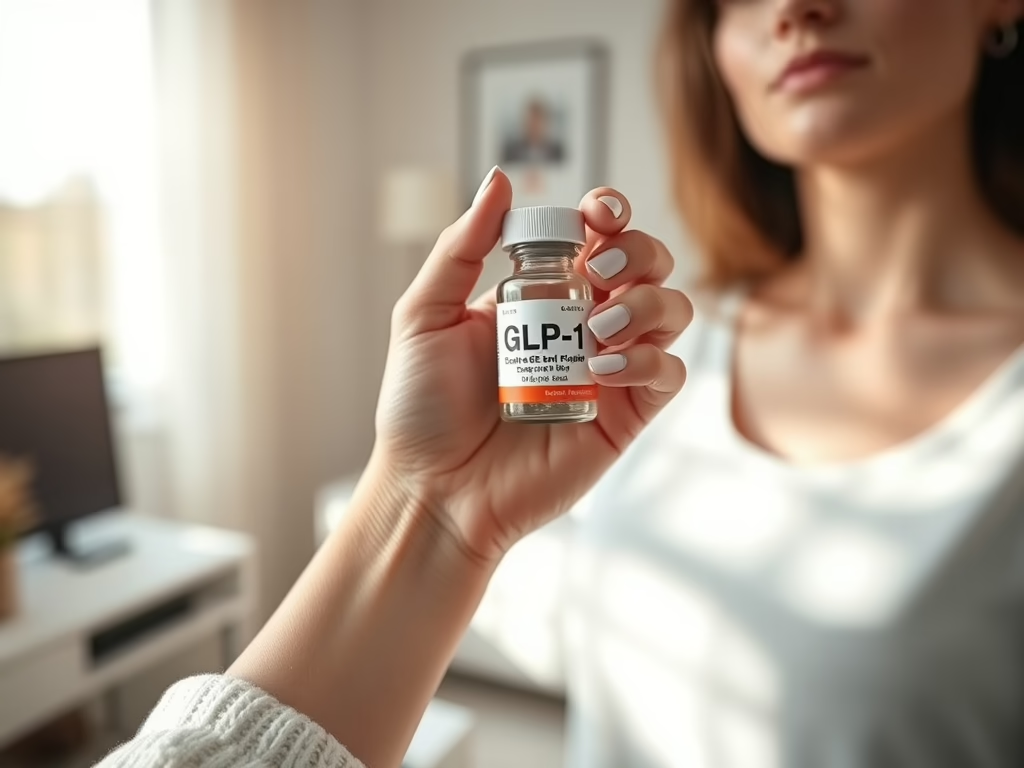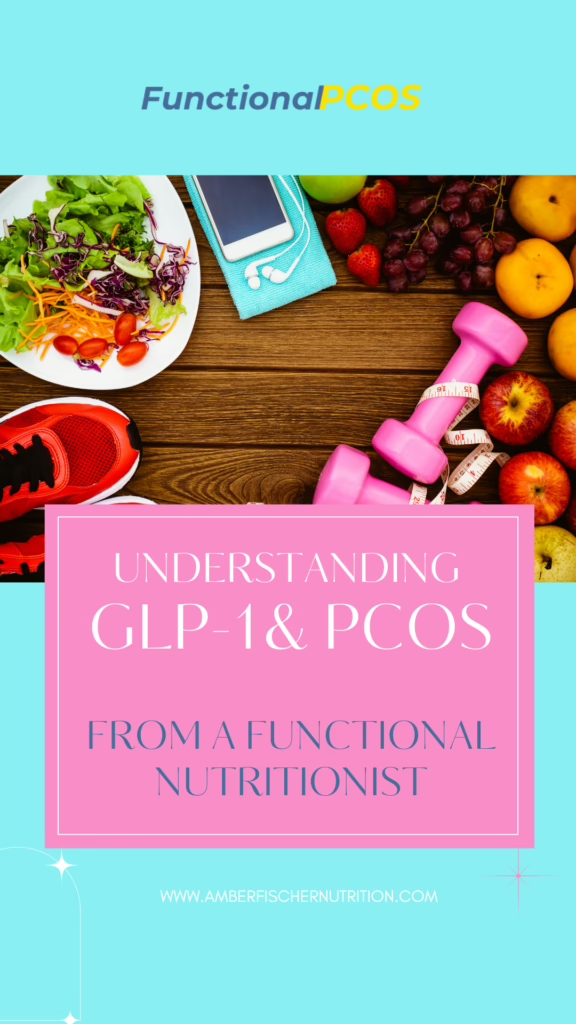- Click to share on Pinterest (Opens in new window)Pinterest
- Share using Native toolsShareCopied to clipboard
- Click to share on X (Opens in new window)X
GLP‑1 for PCOS: Nutrition Tips for Safe & Effective Weight Loss

GLP-1 for PCOS: How to Use It Safely and Effectively
If you’re living with polycystic ovary syndrome (PCOS), you’ve probably heard the buzz around GLP-1 medications like Ozempic, Wegovy, or Mounjaro or maybe just semiglutide in general. Maybe your doctor has recommended one. Maybe a friend has had amazing results. Maybe you’re wondering if it’s just another fad or a real breakthrough in PCOS treatment.
As someone with PCOS myself and a nutritionist who works with hundreds of women navigating this exact question, I want to walk you through what’s true, what’s hype, and what you actually need to know. I also want you to get the best advice for how to make real lifestyle changes to take advantage of these drugs and make them work for YOU.
This is your full breakdown: how GLP-1 receptor agonists work, why they may help in PCOS, the risks nobody talks about, and how to support your body if you’re using them. Whether you’re just starting out or trying to decide if it’s right for you, this guide will help you make empowered, educated choices.
What Are GLP-1 Medications? | GLP-1 for PCOS
GLP-1 (glucagon-like peptide-1) is a hormone your body naturally makes in the gut when you eat. It signals satiety (feeling full), slows down gastric emptying, and boosts insulin production only when blood sugar is high which makes it uniquely helpful for people with insulin resistance.
GLP-1 medications mimic this hormone and are FDA-approved for type 2 diabetes and obesity. But because PCOS is strongly linked to insulin resistance and metabolic dysfunction, we’re now seeing these meds used off-label in women with PCOS with a lot of promising results. I myself have seen an increase in clients using these meds and most of them have had positive experiences overall.
Why a GLP-1 for PCOS Might Help
Let’s start with the potential benefits. PCOS is fundamentally a metabolic condition. Most women with PCOS have some degree of insulin resistance. This drives high insulin levels, which in turn stimulate ovarian androgen production. That cascade contributes to irregular cycles, facial hair, acne, and anovulation. My Beginner Guide to Nutrition for Polycystic Ovary Syndrome (PCOS)
may help illuminate some of this for you. I’d also recommend this podcast I recorded on insulin resistance in PCOS.
GLP-1s interrupt that cascade in a few ways:
- They reduce appetite and promote weight loss (which lowers insulin levels)
- They increase insulin sensitivity
- They improve post-meal glucose levels (blood sugar spikes)
- They help reduce visceral fat (the deep belly fat linked to inflammation and hormonal imbalance)
For some women, GLP-1 medications feel like unlocking a door their body has had bolted shut. Hunger calms down. Blood sugar stabilizes. Energy improves. They finally feel in control of their body.
But It’s Not a Magic Wand: Here’s What to Watch Out For
A GLP-1 for PCOS isn’t without downsides. These are powerful medications. And just because something helps you lose weight doesn’t mean it automatically improves health.
Here’s what I want you to be aware of:
1. Muscle Loss is a Real Risk
GLP-1 meds reduce appetite, which leads to fewer calories, often much fewer. If you’re not intentional about eating enough protein and strength training, you can lose significant muscle mass, not just fat. Muscle is critical for metabolic health, insulin sensitivity, and hormone balance.
Support strategy: Aim for 100+ grams of protein per day (about 30g per meal). Use protein powders if you’re not hungry. I recommend a high quality protein powder like the ones from Be Well By Kelly– these are hypoallergenic, low on sugar and taste delicious. You can use my code AMBER10 for a discount. Resistance training 2–3x per week is non-negotiable.
2. Nausea and GI Symptoms Can Disrupt Nutrition
Many women feel so nauseous on GLP-1s that they skip meals or live on crackers. This backfires fast in PCOS as low nutrient intake makes hair loss worse, crashes hormones, and destabilizes mood.
Support strategy: Eat small, balanced meals with protein and fat. Ginger tea, peppermint oil capsules, and magnesium glycinate can help reduce nausea. Don’t skip meals, just adjust the size.
3. GLP-1s May Suppress Ovulation Temporarily
Some women report that their cycles disappear on GLP-1s. This may be due to rapid weight loss, under-eating, or changes in hormone signaling. I’ve noticed over the years with clients that rapid weight loss tends to stir up hormone issues and can sometimes make them a little worse for a while.
Support strategy: Track your cycles and ovulation symptoms. Ensure you’re eating enough total calories (even if you’re losing weight). If you lose your period, check in with your provider and consider labs to assess estrogen, LH, and progesterone.
4. Unsustainable Patterns May Emerge
When appetite is suppressed and weight loss is occuring, it can be very tempting to develop unhealthy patterns of undereating and not paying attention to vitamins, minerals, or overall diet quality. The feeling that things will always be this way tends to take over and it’s so nice to not have that food noise that women sometimes forget to work on building healthier patterns.
The truth is, the first thirty pounds might be fairly easy to lose on a GLP-1 but after that, and especially if you ever stop taking them, old patterns and habits may creep back in and block further progress.
Support strategy: Ensure you know your TDEE (Total Daily Energy Expenditure) and are eating no more than 1000 calories under that daily. This will keep weight loss to around 1-2 lbs a week which is healthy and sustainable. Within that range, make sure you are working on building a taste for vegetables and healthier foods by making it a priority to consume them with every meal. Pay attention to the nutrition makeup and composition of your meals during this time, this can help rewire your brain for positive habits when you eventually stop the GLP-1.
What I’ve seen in real women
At this point I’ve now had a case sample of around 30 clients who were on some kind of GLP-1 for PCOS. Their experiences have been eerily similar so I thought I’d share them with you. Keep in mind that everyone is different and this is a small sample set, so it may not apply to everyone who takes a GLP-1 for PCOS.
Overall, my clients have experienced positive benefits to PCOS symptoms, including weight loss. We’ve seen reduced facial hair and improved ovulation. The first 30 lbs seems to come off fairly easily and then they typically need to go up on their medication.
Whenever starting or increasing doses, many of my clients have struggled with nausea and fullness. In fact, gastric symptoms of nausea, overfullness, and constipation have been the main issues my clients have experienced. For some, it was unpleasant enough that they decided to discontinue medication. For others, it wasn’t bad enough to outweigh the benefits.
It seems like around the 30 lb mark, there has to be an increased effort from my clients to improve their diets and exercise routines. If they don’t stick closely with some changes here, they often seem to stall out.
How to Make the Most of GLP-1s for PCOS

These medications can be a game changer but only if you support your body while you’re on them. Here’s how to do it right:
Prioritize Nutrient Density
Every bite matters when appetite is low. Focus on protein, healthy fats, and nutrient-dense veggies. Smoothies, soups, and soft foods can be easier when nausea is high. Add PCOS superfoods that boost nutrients. Here’s an article I wrote on that. And here’s an article on how to design a PCOS diet appropriately.
Track Your Labs
GLP-1s may affect thyroid hormones, liver enzymes, and even gallbladder function. Ask your provider to monitor these regularly, especially if you feel fatigued or have a history of gallbladder issues.
Labs to request:
- A1C and fasting insulin
- Comprehensive metabolic panel
- TSH, free T3, free T4
- Lipid panel
- LH, FSH, estradiol, progesterone (mid-luteal phase)
Cycle Off Thoughtfully
Some women want to use GLP-1s as a “jumpstart.” That’s okay but know that long-term success means building habits that support blood sugar and hormone balance after the medication ends.
Build a support plan with:
- A post-med nutrition strategy
- Sustainable exercise habits
- Gut and hormone support (I highly recommend my PCOS Insulin Resistance kit for supplementation, or one of my other PCOS Fullscript protocols available here. )
Who Should Be Cautious?
GLP-1s may not be a good fit if you:
- Have a history of disordered eating
- Are trying to conceive right now
- Have thyroid nodules or a family history of medullary thyroid cancer
- Struggle with severe GI conditions like gastroparesis
Always work with a knowledgeable provider who understands PCOS, not just weight loss.
Final Thoughts
A GLP-1 for PCOS can be a powerful tool but it’s not a standalone solution. It works best when paired with root-cause strategies: blood sugar support, hormone-friendly nutrition, stress management, and strength training.
Whether you’re using Ozempic, Wegovy, Mounjaro, or another GLP-1 med, your body still deserves care, nourishment, and support.
And you deserve more than weight loss. You deserve to feel good in your skin, to understand what your body needs, and to be fully informed every step of the way.
Looking for a meal plan or supplement protocol that supports GLP-1 and PCOS? Download my free guide here or check out my PCOS nutrition course and meal plan: PCOS Foundations.
- Share using Native toolsShareCopied to clipboard
- Click to share on Pinterest (Opens in new window)Pinterest
- Click to share on X (Opens in new window)X

GLP‑1 for PCOS: Nutrition Tips for Safe & Effective Weight Loss
Amber Fischer, MS, CNS, Functional Nutritionist
June 13, 2025
MEdical Disclaimer
The information contained on amberfischernutrition.com is for informational and education purposes only and should not be construed as medical advice. As a nutrition professional, I draw upon evidence based practices and personal experience with myself and clients to form recommendations like the ones made in this guide. You are an individual with your own unique set of health goals and concerns. Ensure you discuss any changes to your diet with a qualified healthcare professional, like your doctor, to ensure these changes are right for you. This is especially important if you have any other underlying medical conditions. Do not consume foods you are allergic to. Results will be individual and will vary.
Affiliate Disclosure
This site contains affiliate links. When you make a purchase through a link provided on this website, I may make a small commission. This does not add to the purchase price of the item. I only link to items I truly use and recommend.